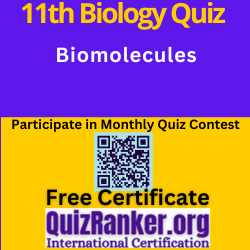Test your knowledge with our Biomolecules MCQ Test for 11th Biology Chapter 9. This MCQ Test covers carbohydrates, proteins, lipids, and nucleic acids to help you understand the chemical basis of life.
Attempt Biomolecules MCQ Test
Attempt Chapter wise 11th biology MCQ Test and Monthly Quiz contest of Biology 11th grade.
Summary for Biomolecules MCQ Test
Living organisms show great diversity, yet their chemical composition and metabolic reactions are quite similar. Both living tissues and non-living matter contain similar elements, but living systems have higher levels of carbon, hydrogen, and oxygen. Water is the most abundant chemical in living organisms.
There are many small biomolecules in living organisms, including:
- Amino acids: 20 types
- Sugars: Monosaccharides and disaccharides
- Fatty acids and glycerol
- Nucleotides: 5 types
- Nucleosides and nitrogen bases
Fats and oils are glycerides where fatty acids are esterified to glycerol. Phospholipids also include a phosphorylated nitrogenous compound.
There are three main types of macromolecules in living systems:
- Proteins
- Nucleic acids (RNA and DNA)
- Polysaccharides
Lipids, associated with membranes, are also considered in the macromolecular fraction. Biomacromolecules are polymers made of different building blocks:
- Proteins: Made of amino acids and perform various cellular functions, such as enzymes, antibodies, receptors, hormones, and structural proteins like collagen (most abundant in animals) and RuBisCO (most abundant in the biosphere).
- Nucleic acids: Composed of nucleotides and serve as genetic material.
- Polysaccharides: Components of cell walls in plants and fungi, exoskeletons in arthropods, and storage forms of energy (e.g., starch and glycogen).
Enzymes are protein catalysts that speed up biochemical reactions by lowering activation energy. They are specific to substrates and work best at optimal temperatures and pH levels. High temperatures can denature them. Ribozymes are nucleic acids with catalytic power. Nucleic acids carry hereditary information from one generation to the next.
Chapter wise biology 11th grade mcq
Chapter 1 The Living World MCQ Test
Chapter 2 Biological Classification MCQ Test
Chapter 3 Plant Kingdom MCQ Test
Chapter 4 Animal Kingdom MCQ Test
Chapter 5 Morphology of Flowering Plants MCQ Test
Chapter 6 Anatomy of Flowering Plants MCQ Test
Chapter 7 Structural Organisation in Animals MCQ Test
Chapter 8 Cell The Unit of Life MCQ Test
Chapter 9 Biomolecules MCQ Quiz
Chapter 10 Cell Cycle and Cell Division MCQ Test
Chapter 11 Photosynthesis in Higher Plants MCQ Test
Chapter 12 Respiration in Plants MCQ Test
Chapter 13 Plant Growth and Development MCQ Test
Chapter 14 Breathing and Exchange of Gases MCQ Test
Chapter 15 Body Fluids and Circulation MCQ Test
Chapter 16 Excretory Products and their Elimination MCQ Test
Chapter 17 Locomotion and Movement MCQ Test
Chapter 18 Neural Control and Coordination MCQ Test
Chapter 19 Chemical Coordination and Integration MCQ Test
Source for Study
Total Views: 9


